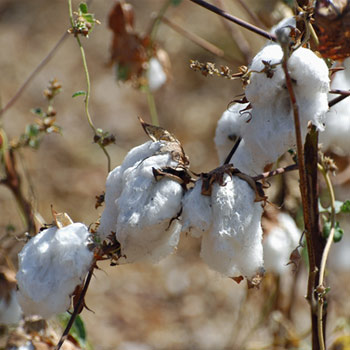
What should I know before investing in cotton?
Cotton is an agricultural commodity used principally in the textile industry for the creation of material. Although the use of cotton in the textile industry has dropped from 71% to 40% since 1950 it is still a favoured material in this industry.
Concerning production, several large countries share the honour with China at the head followed closely by the United Sates, India and Pakistan. In total 30 million tons of cotton are produced each year. It is however China that produces a quarter of the global production as the market leader. This country therefore plays a primordial role in the quote of the cotton price as a commodity.
In 2011, the cotton market was virtually in short supply after several years of low prices and a fall in the area under cotton. As a result, this year's harvest was the smallest in 7 years due to poor weather conditions. China was forced to import on a massive scale, and global demand fell sharply as a result of the economic crisis, despite a fall in world stocks. As a result, the price of cotton soared on the NYLEX, reaching up to 2 dollars a pound in 2011, an increase of 100% in 5 months.
Demand then fell again, and stocks were quickly replenished, allowing prices to return to normal levels of around 80 cents per pound between 2012 and 2014, a price that fell further in 2015 to 60 cents per pound.
Invest in cotton (CFD)!{etoroCFDrisk}% of retail CFD accounts lose money - etoro.com
How to invest in cotton online?
There are several options for investing in cotton online. The choice of one or the other of these methods that we will present here will depend mainly on your knowledge and your level of risk aversion. It is also possible to diversify your cotton investments by choosing several of these investment methods. Here are the main ways to invest in cotton online:
- Cotton futures: Cotton futures are used to speculate on the future price of cotton. Investors buy or sell futures contracts for a certain quantity of cotton at a pre-agreed price. Futures contracts are traded on commodity markets around the world. However, it is important to note that futures contracts are a risky investment and require in-depth knowledge of the market.
- Exchange-traded funds (ETFs): Cotton-related ETFs offer a simpler and more accessible way to invest in cotton. ETFs allow investors to buy a share of a portfolio of shares of companies involved in the cotton industry, or a cotton futures fund. ETFs can be bought and sold on exchanges like stocks.
- Shares of cotton-related companies: Investors can also buy shares of companies involved in the cotton industry, such as producers, processors or distributors. Before investing in shares, it is important to understand the company's business, financial health and potential risks.
- CFDs (contracts for difference): Cotton CFDs allow investors to speculate on cotton price fluctuations without having to physically own the commodity. CFDs are financial instruments that allow investors to trade up or down in the financial markets. Cotton CFDs are offered by many online brokers, but it is important to note that CFDs are a risky investment and require a thorough knowledge of the market.
It is important to note that investing in cotton can be risky due to price volatility and market risks. It is therefore recommended to do thorough research and consult a financial advisor before making an investment decision.
Invest in cotton (CFD)!{etoroCFDrisk}% of retail CFD accounts lose money - etoro.com
How can I analyse the price of cotton?
Like all commodities, cotton is traded in the form of futures and options. It is mainly quoted on the ICE market in the United States. However, the way in which cotton prices are set does not depend solely on supply and demand, since the US market includes government support for this production sector.
This is why the prices paid to American cotton growers are often higher than those paid to other international producers. However, the US government has decided to reduce this support from 2013.
The choice of charts you use to carry out a technical analysis of the live cotton price depends on the way you want to trade it and, more specifically, the duration of your investment. You will prefer historical charts for the long term and Japanese candlesticks in minutes for the short term.
You should also feel free to use the many technical analysis tools that are usually offered free of charge by trading platforms. These may include signals or precise indicators such as technical support and resistance levels.
Calculating the price of cotton
The price of cotton, like that of any other commodity traded on the stock market, is primarily determined by calculating the difference between the strength of demand and the strength of production. It is therefore the scarcity of this commodity that drives up its value, because the greater the demand in relation to supply, the more traders buy this asset, and vice versa when supply exceeds demand.
But other fundamental factors also influence the value of cotton by acting precisely on this difference between supply and demand.
Supply and demand and their influence on cotton prices
Let us examine the two major factors that primarily influence the price of cotton, global supply and demand.
- The supply: Cotton is grown in areas with a certain climate featuring alternating periods of dryness and humidity. The cotton fibres are generally separated from the seeds. The fibre is used as thread in the textile industry and the seeds for the production of alimentary oil and animal protein. India is actually the largest producing country worldwide at 6.6 million tons, just above China which boasts a production of 6.5 million tons. In third position is the United States with n annual cotton production of 3.5 million tons then there is Pakistan, Brazil and Turkey. However, the leading global exporter of cotton is the United States partly due to the fact that its agriculture is heavily subsidised thereby enabling production that is higher than its actual requirements.
- The demand: A significant fall in the use of cotton by the textile industry can be noted over the last few decades, particularly since the 1950s, due to the appearance of synthetic fibres on the market. However, the demand remains fairly stable due to population growth which compensates for the former. The major consumers of cotton are the developed countries with a significant textile industry such as China which is also the leading cotton importer worldwide but also India, Pakistan and Turkey.
How do I create an online cotton trading account?
Here are the steps to follow to start trading cotton online:
- Choose a broker: Look for a regulated and reliable broker with an intuitive trading platform and competitive fees.
- Fill in the registration form: Provide your personal and financial details, including your social security number and proof of address.
- Verify your identity: Upload a copy of your ID and proof of address.
- Deposit funds: Deposit the minimum amount required to open a trading account.
- Choose an account type: There are different account types, such as the standard account and the mini account.
- Download the trading platform: Install the trading platform on your computer or mobile device.
- Start trading: Search for the cotton contract you wish to trade and place your order.
Invest in cotton (CFD)!{etoroCFDrisk}% of retail CFD accounts lose money - etoro.com
History and evolution of the price of cotton on the stock market
19th century:
- Cotton was mainly grown in Asia and North America for the textile industry.
- The price of cotton was relatively stable.
20th century:
- Cotton production increased significantly in the United States and Asia.
- Cotton was used for other products such as tyres and pharmaceuticals.
- Cotton prices experienced some volatility, but generally followed an upward trend.
21st century:
- Global demand for cotton has increased due to population growth and urbanisation.
- Cotton production increased in Africa and South America.
- Cotton prices rose sharply in the early 2000s, followed by a period of volatility.
- Since 2014, cotton prices have tended to fall due to increased production and lower demand from China.
To better understand the recent evolution of the cotton price, here is a table of its history over the last 10 years:
| Year |
Average price (cents per pound) |
Change from previous year |
| 2014 |
92.5 |
+12.8% |
| 2015 |
62.0 |
-33.3% |
| 2016 |
60.5 |
-2.4% |
| 2017 |
72.5 |
+20.0% |
| 2018 |
89.0 |
+22.9% |
| 2019 |
67.5 |
-24.1% |
| 2020 |
69.0 |
+2.2% |
| 2021 |
87.0 |
+26.1% |
| 2022 |
81.5 |
-6.3% |
| 2023 |
83.0 |
+1.8% |


